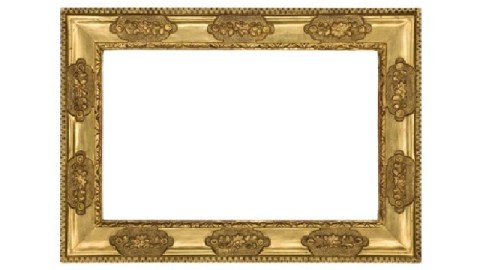Framing the Issue: Looking Closer at the Art of the Frame

We see them every time we go to a museum, but we never really see them. Like Rodney Dangerfield, frames get no respect. Julius Lowy Frame & Restoring Company, Inc. hopes to reframe the issue of frame ignorance through an exhibition titled A Change of Taste: From the Gilded Age to the Craftsman Aesthetic; Featuring Beaux Arts and Arts & Crafts frames from The Edgar Smith Collection, which runs through April 15, 2011. By showing the artistry of these frames, Lowy harks back to an age when craftsmanship in frame design earned great respect from the artists whose works filled in the spaces between the gilding and carving.
“While being an artist is considered a calling, it is said that no one sets out to be a framer,” co-curators Tracy Gill and Simeon Lagodich write in the catalog. “With a few rare exceptions, most people come to the appreciation of framing as a second or third career. To specialize in period frames is a step even further.” The show brings together not only Lowy’s collection of Beaux Arts and Arts and Crafts frames, but also those owned by “maverick” collector Edgar Smith, who has specialized in amassing a collection of the American branch of the Arts and Crafts movement often considered to be an exclusively British phenomenon.
“In late 19th century America, frames were for the most part heavy and elaborately-cast borders that were made in factories and related little to the paintings they surrounded,” Lisa Wyer explains. “But Stanford White, one of the most important tastemakers of his time, eschewed these cumbersome products of the industrial age. He believed that the frame should be beautiful in its own right and an integral part of the work of art it encased.” Artists such as Abbott Handerson Thayer, George de Forest Brush, Thomas Wilmer Dewing, and Dwight Tryon found a sort of collaborator in White, who individualized the frames to suit the work at hand. Similarly, Charles Prendergast, less-famous brother of painter Maurice Prendergast, saw his frames as complimenting the artwork rather than simply accompanying it. In the example shown above from 1905, Charles used an Italian technique of punch work called bulinatura around the carved floral embellishments in an attempt to recreate the classic frames of early 18th century Venice. The lack of uniformity of the floral touches accents the human touch and separates Prendergast’s work further from the chilly perfection of mass production.
The exhibition spotlights other artists of the frame such as Hermann Dudley Murphy, a friend and neighbor of Charles Prendergast who made frames for paintings by William Merritt Chase and Childe Hassam, among others; the firm of Newcomb-Macklin, who sold frames to John Singer Sargent, George Bellows, and others; and Frederick Harer, who helped frame the Pennsylvania School of Impressionism, including Daniel Garber and Edward W. Redfield.
A Change of Taste may find a challenge in overcoming the change in taste that’s taken place since the early 20th century. The Abstract Expressionists did away with the frame altogether, and many other artists use frames only “ironically.” The Isabella Stewart Gardner Museum commemorates the infamous theft of 1990 by placing empty frames on the wall where the missing once were. The frames in A Change in Taste haunt in a different way by recalling a time when craftsmanship and collaboration helped launch a golden moment in American art. Perhaps such consciousness-raising shows can frame the issue of framing in a positive light once more.
[Image: A rare carved and gilt frame by Charles Prendergast with ogee profile and intermittently spaced floral carvings alternating with plain burnished “mirror” panels in the Venetian style. The Italian technique of punch work or bulinatura is used around the floral carvings. This frame resembles a classic Venetian carved frame with an ogee profile dating from the early 18th century sometimes referred to as a “Canaletto” frame. Hermann Dudley Murphy used this frame style as well and was also influenced in many of his designs by Italian techniques and ornamentation. Signed and dated on verso “Prendergast 1905.” Sight 25 5/8 x 15 ¾ inches; width 4 inches.]
[Many thanks to Julius Lowy Frame & Restoring Company, Inc. for providing me with the image above and press materials for A Change of Taste: From the Gilded Age to the Craftsman Aesthetic; Featuring Beaux Arts and Arts & Crafts frames from The Edgar Smith Collection, which runs through April 15, 2011.]




